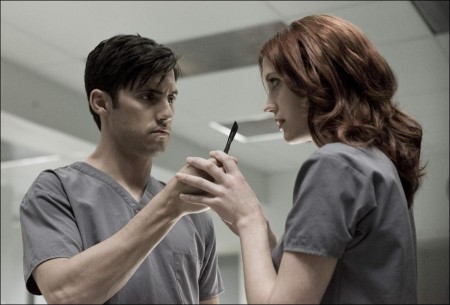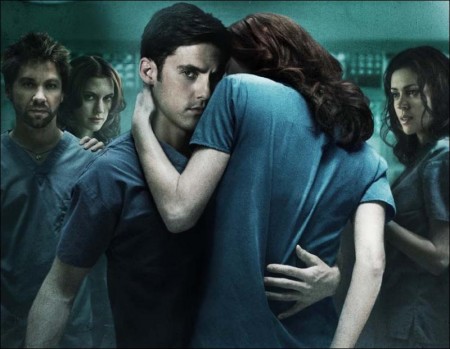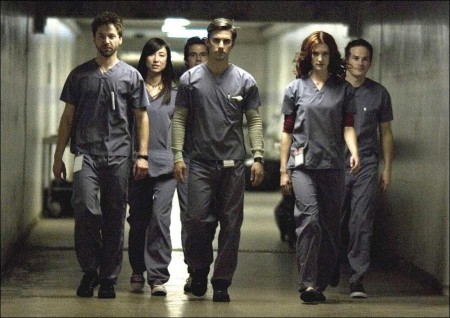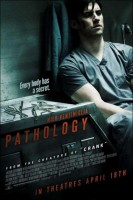Tagline: Everybody has a secret.
“Pathology” about a group of med students who hatch a scheme to see who can commit the perfect crime — one that even a fellow pathologist couldn’t unravel.
Some say that Pathology is a window to God. As doctors, they see the perversion and corruption of the flesh by all means unnatural… by violence… by toxin… by madness… to determine the cause of death. As a result they are the experts in all signs of foul play and the best in the field can uncover all means of killing, even those that are seemingly undetectable.
When med school student Ted Gray (Milo Ventimiglia) graduates top of his class he joins one of the nation’s most prestigious Pathology programs. With talent and determination Ted is quickly noticed by the program’s privileged and elite band of pathology interns who invite him into their crowd. Intrigued by his new friends he begins to uncover secrets he never expected and finds that he has unknowingly become a pawn in their dangerous and secret after-hours game at the morgue of who can commit the perfect undetectable murder. As Ted becomes seduced into their wild extracurricular activities the danger becomes real and he must stay one step ahead of the game before he is the next victim.
About the Production
PATHOLOGY charts the struggle of Ted Gray, young doctor who is challenged and manipulated by a selective group of his peers to whom murder is just part of a gory game. While the doctors indeed kill in and gruesome ways, the film’s disturbing premise is heightened by how convincingly Ted’s decent into his colleagues’ sinister activities is presented. “The scariest part of this movie is that it could be anyone of us,” says Mark Neveldine, a co-writer and producer of the film. “Anyone of us could be seduced to dark side.”
A commitment to underscoring the film’s plausibility unified the creative team, including director Marc Schölermann. “When Marc gave us his pitch on this movie, he stripped it all down and said, `I see this is as real,” explains Neveldine. “`These are highly intelligent people-highly disturbed individuals.’”
The key actors cast in PATHOLOGY were also excited to see that the film transcends the campy tones and gratuitous violence of traditional horror movies. “It’s a thriller,” says cast-member Milo Ventimiglia. He explains, “A thriller to me seems like an intensity of character that could actually happen.”
Fellow cast-member Michael Weston concurs, “What I loved about the script is that it isn’t just a straight-up horror movie. It’s really a psychological thriller.”
“It deals with the dichotomy of human nature. We all have this good side and this bad side to us,” explains cast-member Alyssa Milano, who admits to being frightened the first time she read the script. “The things I find the scariest are the things that could potentially happen.”
“It reminded me of Flatliners and Se7en,” says cast-member Lauren Lee Smith, “and those are the kinds of films I love to watch.”
The film gathers a lot of it substance from a dark corner of the medical world. Pathologists aren’t like other doctors. Whereas a general practitioner looks for ways to keep a patient alive, forensic pathologists dig inside corpses searching for the cause of death. For the creative team behind PATHOLOGY, tapping into the “morgue mindset” was critical and revealed that even good doctors spend time imagining the perfect murder. “It was so funny being in the coroner’s office,” says Ventimiglia. “You’d ask the guys, `How would you kill someone?’ They’d look around and say, `Everyone has their formula, ideas and theories about how they would kill someone.”
Shadowing working pathologists also prepared the actors for the everyday realities of dealing with cadavers. “It was extremely helpful to go into the morgue,” says Smith. “That was incredible to be able to watch the autopsies and to see how they handled the bodies.” She was particularly taken aback with how rough the doctors had to be with the deceased as they sliced or cracked their way inside for a closer look.
It may have been initially shocking for the actors to witness autopsies, but the experiences did lend a necessary authenticity to their performances. “They needed access to that world,” says co-writer and producer Brian Taylor. Otherwise, he continues, “It’s like having someone play a cop, and they’ve never fired a gun before.”
Throughout PATHOLOGY, the doctors are called upon to routinely remove and weigh organs, open rib cages and reach inside dead bodies. Only the weak get squeamish, and the very best can be quite irreverent in how they treat the dearly departed. The attitudes and the procedures are grounded in fact. Adds director Marc Schölermann, “Everything that’s in [the film]-the gore, the blood-is reality based. There was no sort of let’s invent cruel methods to cut up people. Everything you see is real and is being done everyday in pathology labs and morgues.”
Since dealing with corpses for a living can be emotionally draining, many pathologists develop a clinical view of the lifeless bodies on the slab. Instead of seeing a dead grandmother or a young man, they see a subject with signs of a massive aneurysm or an open-and-shut case of death by asphyxiation. The legitimate need for pathologists to examine cadavers without creating deep emotional attachments feeds into the film’s premise. Part of what makes it possible for the doctors in PATHOLOGY to kill for sport is that they are already incredibly accustomed to the messy, disturbing and gruesome toll that death can demand of the human body. They revel in the CSI-type forensic details.
With their cold clinical eyes and in their competitive environment, the bright pathologists in the film are particularly primed to take their pursuits to the extreme. “[The game] goes further than we’d ever dreamed it would go, but we instigate that with each other,” says Weston, discussing the group of doctors that turn homicides into brainteasers. “We’re top notch, and we have the intellectual arrogance which accompanies that.”
Arrogant, conflicted or misled, the central characters in PATHOLOGY presented the lead actors with roles they were eager to accept. “It wasn’t one note of a character,” says Ventimiglia, who stars as Ted Gray. “You actually get to see several different sides. It’s fun stuff to play with.”
Weston, who portrays Jake, Ted’s relentless rival and the leader of the pathologists killing for sport, relished the complexities in a cocky doctor that at first glance might seem simply unsympathetic. “He puts on this veneer of having it all together,” says Weston, “but it gradually unravels.”
Smith is less charitable in describing her character, the pathologist Juliette. “She’s mean and vindictive.” Yet, Smith adds, “That’s what I like about playing her. I get to go completely outside of myself.”
While most of his colleagues exert a negative influence on him, Ted does have one trustworthy person in his private life: his fiancée, Gwen, who is portrayed by Milano. “Gwen represents all the goodness and love in his life. She’s the opposing force to his darkness,” says Milano.
Ted and Gwen’s romance rings true, but like the other various ties between the characters in PATHOLOGY, it required the actors to develop authentic bonds with one another. “Alyssa and I just spent some together, grabbed a bite to eat here and there, and chatted on the phone,” says Ventimiglia. “You have to have that comfort with someone to make it real.”
The demanding and antagonistic relationship between Ted and Jake called for a special chemistry all its own. Describing the mixed emotions linking the two pathologists, Weston says, “They admire each other, and at the same time, they can’t live in the same bubble.”
Since violence eventually irrupts between Ted and Jake, the actors had to develop a confidence in each other that goes beyond having faith that your partner will hit his mark and remember his lines. “I held a live scalpel over the guy’s chest. I asked him, ”Do you trust me, and he said he did,” says Ventimiglia. “Same thing for me when he’s swinging a pair of bone shears in front of my face. I trusted the guy implicitly. He wasn’t going to let it get to the point where he was putting me in danger just like I wasn’t going to put him in danger.”
Weston asserts that their mutual respect enhanced their performances. “[Milo] is a superb actor. He’s really right on point every single moment with me whether he’s on screen or off,” he says. “I feel we’ve developed a good friendship off screen. That pops into the film.”
Ventimiglia and Weston felt comfortable taking risks in scenes together. “That’s when you get those cool moments as an actor where they’re real,” explains Ventimiglia. “It reads as the most honest interpretation of these words that have been written for a long time. They’re coming out of your mouth like it’s the first time.” Schölermann undoubtedly helped foster the productive environment that pervaded the film shoot, and he developed his own relationships with the cast members. “He’s got a really specific vision, which is amazing for actors to work with directors like that because you feel like you’re protected,” says Milano. “He allows us freedom to explore and come up with ideas, but we know there is a safety net there.”
For his part, Schölermann credits the creative team behind Crank, which produced PATHOLOGY. The director had heard all the Hollywood horror stories about bad professional marriages between directors and producers. He was delighted that none of the notorious pitfalls were encountered on this project. Schölermann attributes the success to a shared vision. “We have the same sick humor and twisted taste. It’s a really cool collaboration.”
Production notes provided by Metro Goldwyn Mayer.
Pathology
Starring: Milo Ventimiglia, Lauren Lee Smith, Johnny Whitworth, Alyssa Milano, Keir O’Donnell, Dan Callahan
Directed by: Marc Schoelermann
Screenplay by: Mark Neveldine
Release Date: April 18th, 2008
MPAA Rating: R for disturbing and perverse behavior throughout, including violence, gruesome images, strong sexual content, nudity, drug use and language.
Studio: Metro Goldwyn Mayer
Box Office Totals
Domestic: $109,045 (3.5%)
Foreign: $3,010,473 (96.5%)
Total: $3,119,518 (Worldwide)



